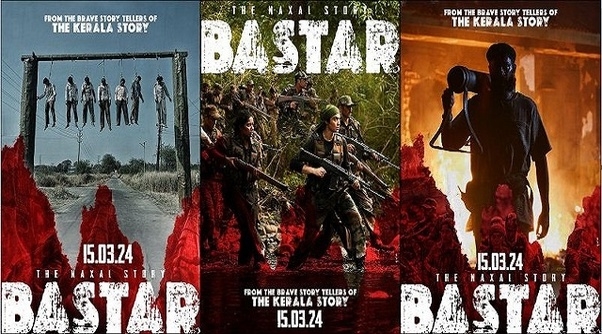'Bastar: The Naxal Story' is a reality check on big screen
The film starring Adah Sharma, features bold graphic scenes which one may be shocked to see at first but carries the irrefutable essence of the truth for who can refute the evidence when Maoists themselves have come forward to publicize their brutal executions.

It is true that ignorance is bliss. Ignorance allows us to ignore the smell of blood in the air as fragrance and the sound of machine guns as firecrackers. In the delusional world where algorithm show us the world we wish to see, where the citizens of Central India know more of encounters in Kashmir and the borders of China but remain oblivious to the red killings, a few kilometres from their cities and where before any news of Dantewada appears in the local newspaper, an article in Washington Post regarding the same is circulated, for such ignorant public including myself, the film 'Bastar: The Naxal Story' is an eye opener, for I may have paid my tributes to the fallen troopers of the Pulwama Attack , but the casualness with which I had forgotten the events of 6th April 2010 where 76 troops of CRPF and CG Police were murdered by the Naxals in Dantewada, brings shame to myself.
Even the once who read about the Naxal problem have done it only as a statistical study, as Tucholsky writes , "… The death of one man: this is a catastrophe. Hundreds of thousands of deaths: that is a statistic!". After reading of few deaths every now and then, it creates a thick skin over our heart, when we start tending our attention only to the deaths in double digits and conveniently ignore the single digit tragedies as a triviality. Probably this thick skin attitude is the cause of our ignorance of the Naxal issue, however the film brings us an opportunity to revisit the war which is going on in our periphery.
The film starring Adah Sharma, features bold graphic scenes which one may be shocked to see at first but carries the irrefutable essence of the truth for who can refute the evidence when Maoists themselves have come forward to publicize their brutal executions . As one watches the great violence one can face the question whether it is really the way it is shown? But within seconds anyone who hears the news will be reminded that the incidents as shown in the film are actual events. one reminded of the Jhiram Valley attack on the convoy of Vidyacharan Shulka an INC leader, the Dantewada Attack on 2010 and so on.
The story revolves around a female police officer who has threefold responsibilities- 1) to face the Maoist violence in the field, 2) to face system dwelling speed brakers such as weak hearted politicians and student celebrating the killings of her troopers and lastly 3) her responsibilities to her unborn child. The film is full of contrasts where an expecting mother fights in the Maoist nests, where men are killed of arbitrarily in the so called ‘jan-adalats’ by the Naxals, where the politicians deal with Maoists and where our legal system is used to defend the people who wish to discard our constitution.
The movie exposes that a Naxal is not just a bearded man in the bushes, but Naxals are also among the polished suit wearing class gathering support and funds for the ones in bushes. It shows how sugary arguments in the constitutional courts have been successfully used to take away the arms of one side when Salwajudum was outlawed, which had left the nationalist villagers undefended against the Maoists and how a bail petitions run like Ussain Bolt when they have a red name.
It also exposes the lack of political will and conviction in the minds of the ‘priests of non-violence’ in quick and strategic decision making probably because one collateral or alleged collateral damage can get them the label of a butcher by the left media. It also shows the functioning of the narratives where articles, intellectuals, songs and gatherings are used to favor the Maoists and watching it all one falls into the question as to whether the red though that democracy has failed in India is actually not incorrect? For India is the country which has allowed hippies from JNU to sing abuses against its own forces.
It forces the citizen to decide a case already decided by the mountains of evidence which is- whether Naxalism be neutralized? By the end of the film my decision was ready. But another though which appeared was why hasn’t India, a power with the largest Army and large numbers of CAPFs and police has been unable to destroy Maoists? the answer in one word is amnesia. It appears that the Naxal problem, unlike the issue or former issue of Kashmir was not being given due consideration in the security sphere.
The ignorance is such that even after mass killings of our troopers we still use mere platoon level weapons citing that Naxals are also citizens. It is imperative that the options of gunships and drones be explored in the 21st century to answer Maoists in the language of Mao.
But any weapon will be useless when the forces will be forced to stop by protests, propaganda and by creating delusions in the public minds. The only solution to this is enlightenment through awareness where public will is built to finally send Maoists to where Mao is, and this film is a great effort towards such awareness.
Article by
Shreeacharya Mishra
Younginker
Law Student


